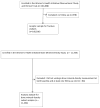Wrist Fracture and Risk of Subsequent Fracture: Findings from the Women's Health Initiative Study
- PMID: 25990562
- PMCID: PMC4615529
- DOI: 10.1002/jbmr.2559
Wrist Fracture and Risk of Subsequent Fracture: Findings from the Women's Health Initiative Study
Abstract
Wrist fractures are common in postmenopausal women and are associated with functional decline. Fracture patterns after wrist fracture are unclear. The goal of this study was to determine the frequency and types of fractures that occur after a wrist fracture among postmenopausal women. We carried out a post hoc analysis of data from the Women's Health Initiative Observational Study and Clinical Trials (1993-2010) carried out at 40 US clinical centers. Participants were postmenopausal women aged 50 to 79 years at baseline. Mean follow-up duration was 11.8 years. Main measures included incident wrist, clinical spine, humerus, upper extremity, lower extremity, hip, and total non-wrist fractures and bone mineral density (BMD) in a subset. Among women who experienced wrist fracture, 15.5% subsequently experienced non-wrist fracture. The hazard for non-wrist fractures was higher among women who had experienced previous wrist fracture than among women who had not experienced wrist fracture: non-wrist fracture overall (hazard ratio [HR] = 1.40, 95% confidence interval [CI] 1.33-1.48), spine (HR = 1.48, 95% CI 1.32-1.66), humerus (HR = 1.78, 95% CI 1.57-2.02), upper extremity (non-wrist) (HR = 1.88, 95% CI 1.70-2.07), lower extremity (non-hip) (HR = 1.36, 95% CI 1.26-1.48), and hip (HR = 1.50, 95% CI 1.32-1.71) fracture. Associations persisted after adjustment for BMD, physical activity, and other risk factors. Risk of non-wrist fracture was higher in women who were younger when they experienced wrist fracture (interaction p value 0.02). Associations between incident wrist fracture and subsequent non-wrist fracture did not vary by baseline BMD category (normal, low bone density, osteoporosis). A wrist fracture is associated with increased risk of subsequent hip, vertebral, upper extremity, and lower extremity fractures. There may be substantial missed opportunity for intervention in the large number of women who present with wrist fractures.
Keywords: FRACTURE; OSTEOPOROSIS.
© 2015 American Society for Bone and Mineral Research.
Figures





References
-
- Owen RA, Melton LJ, 3rd, Ilstrup DM, Johnson KA, Riggs BL. Colles’ fracture and subsequent hip fracture risk. Clin Orthop Relat Res. 1982;(171):37–43. - PubMed
-
- Orces CH, Martinez FJ. Epidemiology of fall related forearm and wrist fractures among adults treated in US hospital emergency departments. Inj Prev. 2011;17(1):33–6. - PubMed
-
- Jones G, Nguyen T, Sambrook PN, Kelly PJ, Gilbert C, Eisman JA. Symptomatic fracture incidence in elderly men and women: the Dubbo Osteoporosis Epidemiology Study (DOES) Osteoporos Int. 1994;4(5):277–82. - PubMed
Publication types
MeSH terms
Grants and funding
LinkOut - more resources
Full Text Sources
Other Literature Sources
Medical

